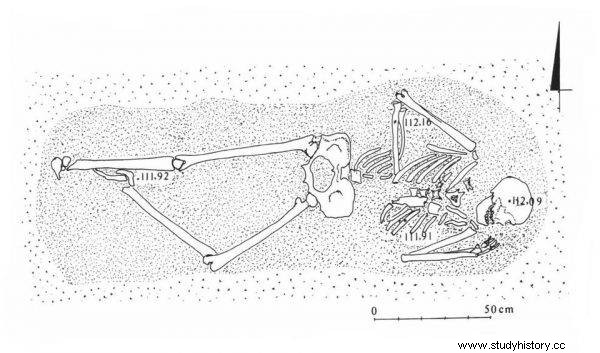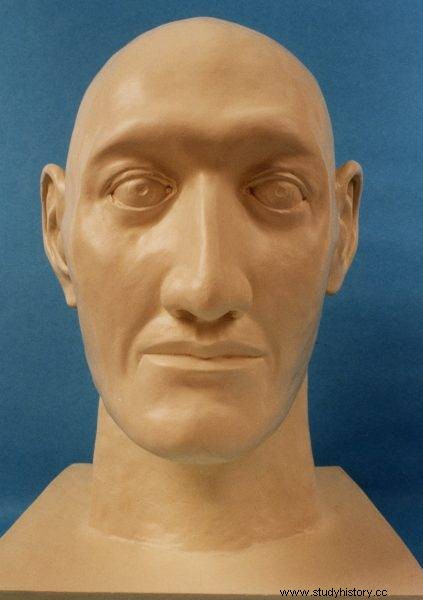It is known that she was exceptionally tall, she could also be mentally ill. Even so, she was probably not excluded from the community in which she lived. However, her grave was different from other burials. Who was the medieval "giant" from Ostrów Lednicki? And what did you manage to read from the traces on her bones?
It was 1977. In Ostrów Lednicki, the largest island on Lake Lednica, where the baptism of Poland probably took place, archaeological research was underway. After many months of excavations, the employees of the Museum of the First Piasts in Lednica found a skeleton that stunned them. Researchers already suspected what period the remains may have come from. So they also knew that this person must have been of extraordinary size. Besides, the arrangement of the bones in the grave did not match the traditional burial.
The well-preserved skeleton was explored, and then research began. These revealed that he belonged to a woman suffering from gigantism and acromegaly. Although it was a unique discovery, the "giant" from Ostrów was forgotten for many years.
Whoever researches doesn't err
The topic returned in the 90s, mainly thanks to prof. Judyta Gładykowska-Rzeczycka from the Department of Anatomy and Anthropology of the Academy of Physical Education in Gdańsk, Anna Wrzesińska from the Museum of the First Piasts and Anna Sokół from the Institute of Radiology of the Medical Academy in Gdańsk. The researchers decided to discover as many secrets as possible related to the "giantess".
However, the condition of bones found two decades earlier deteriorated as the skeleton served for many years as teaching material for students of the Adam Mickiewicz University in Poznań. Nevertheless, there was still a lot to be "read" from it.
First, the 1977 arrangements were refreshed. The tomb of the "giant" was found at the foundations of the no longer existing castle church and dates back to the 12th-13th centuries. The skeleton measured 208 cm and was laid carelessly, which is rather an anomaly in the burials from that period. In 2016, Dr. Magdalena Matczak reported in the media to date:
All the people buried around the giant were arranged in the east-west axis, in accordance with the beliefs of the time, so that after the resurrection they would rise from the graves facing Jerusalem. Instead, she was placed in the tomb with her head facing east and facing south.
In addition, the "giant" was buried on an uneven surface with her left knee bent and her left hand against her face. Meanwhile, the dead were buried with their legs stretched out and their hands stretched along the body. All of this has raised additional questions to which we will probably never know the answer.

The skeleton measured 208 cm and was laid out carelessly, which is rather an anomaly in the burials from that period.
After analyzing the arrangement, it was time to examine the skeleton itself. As it turned out, the woman had massive and unusually long bones. The structure of the skull was also unusual, most likely due to disease associated with high stature. The long, also massive lower jaw was characterized by the presence of right angles. There were cavities in the dentition, but mostly postmortem - which would prove that the "giant" had almost all the teeth at the time of death.
Further tests revealed many diseases that the woman suffered from - incl. She had scoliosis of the spine, tooth decay, pneumonia or hearing disorders. It was also stated with certainty that the "giant" suffered from a benign tumor - osteoma. Numerous healed fractures were also observed, e.g. on the left tibia. However, her basic and most important disease (causing gigantic changes in the skeleton) was disorders of the pituitary gland.
This is only part of the data that the researchers managed to collect. There is no certainty as to the exact age of the "giant". Based on the analysis of the sutures of the skull and the degree of their growth, it was found that she was about 25–30 years old at the time of her death. Nevertheless, it should be presumed that the woman may have been several years older. Sex was determined by examining the pelvic bones - two indicators matched male and four matched female.
Above others' heads
The greatest interest, however, is the height of the woman, which is impressive even today. Certainly, the "giant" stood out from the crowd and looked down on the rest of society. Researchers found that it could measure up to 215 cm! It is worth recalling at this point what was the average height of people at that time. Well, for women it was 153 cm, for men 165 cm. This is an impressive difference. Wherever the "giant" went, it was sure to draw attention to itself.
Was she stigmatized by the inhabitants of the city because of her difference? According to Dr. Magdalena Matczak, a woman with such a large height could function in society, cook or take care of children without any problems. She has probably not been rejected by others, as evidenced by healed fractures or healed pneumonia (meaning she was cared for by other people).

The skull structure was also atypical, most likely due to a disease related to tall stature. The long, also massive lower jaw was characterized by the presence of right angles.
It is not known, however, whether the woman actually functioned normally in society. As Dr. Magdalena Matczak said in 2016, clinical trials showed that especially women suffering from this condition may - although they do not have to, as shown by numerous examples of contemporary people with gigantism - be accompanied by mental illnesses and intellectual disabilities . Perhaps, however, these are only scientists' guesses, and high stature and its "complications" did not make such an impression on anyone at the time. Dr. Matczak reports:
Disability and disease were common. Perhaps even more so than today, as medicine has made progress in this matter. Therefore, among others among the numerous disabled and sick people, the "giant" did not have to stand out very much. Her unusual appearance for us could have been more normal in the eyes of her contemporaries .
Certainly, the woman throughout her life struggled with various ailments, pains and diseases that occur in people suffering from gigantism. In the work of prof. Gładykowska-Rzeczycka we can read:
Extensive degenerative changes, scoliosis, traces of fractures and strains, as well as ossification of ligaments and muscle attachments are a consequence of the main disease - gigantism . There are also changes to the ribs, possibly after pneumonia, as well as changes caused by periodic malnutrition . It is also necessary to mention the openings of the transverse processes of the cervical vertebrae of various sizes, which may cause disturbances in the blood flow in the vessels running through them.
As scientists have established, diseases resulting from complications of gigantism and acromegaly led to the death of the "giant". Although by the "standards" of that time she did not die very young - the average life expectancy of women was then around 25-30 years.

Reconstruction of the face of the "giant"
There is also the question of the burial, which differed from the others. Why was the "giant" buried in such a strange position, without any decorations or personal belongings? Well, only a few of the more than 2,000 known burials in the Lednica necropolis found very modest equipment - in those days this custom was quite rare. The question of the body position remains a mystery - and not only that. There are still many other secrets related to the amazing "giant".
Substantive consultation:employees of the Museum of the First Piasts in Lednica
Bibliography:
-
- J. Gładykowska-Rzeczycka, A. Wrzesińska, A. Sokół, Morphological and radiological examination of a giantess skeleton from an early medieval cemetery in Ostrów Lednicki, Studia Lednickie, 2000, vol. 6, pp. 239–276.
- M. Nowik, Life imprinted in the bones. Secrets of a giant unearthed in Ostrów Lednicki , Dziennik.pl (accessed on 9 February 2021).
- A. Wrzesińska, J. Wrzesiński, Reading from the bone:exhibition , "Studia Lednickie", 2005, vol. 8, pp. 365-368.
- J. Wrzesiński, Discovery and stratigraphy in the area of the tomb 23/77 in Ostrów Lednicki , "Studia Lednickie", 2000, vol. 6, pp. 231–237.
- S. Zdzieśmieowski, Archaeologist:"giant" from Ostrów Lednicki could have been mentally ill , Science in Poland, PAP (accessed on:9/02/2021).
